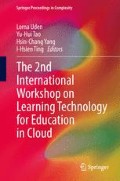Abstract
Advances in technology brought changes to many sectors, including education. With the development of mobile devices and availability of low cost or free online services and applications, the content-centric course design approach and the standard LMS are no longer meeting the student’s preferences and needs. The development of cloud computing and its pay-as-you-go paradigm are a potential solution to the problems which higher education presently has to face—low budget and lack of computing power for researching. Despite the advantages of cloud computing, the universities are late in its adoption due to the security issues. This paper describes the situation at the University of Rijeka, Department of Informatics, and the process of migration to a new cloud-based learning platform.
Access this chapter
Tax calculation will be finalised at checkout
Purchases are for personal use only
References
Kurilovas E, Serikoviene S (2010) Learning content and software evaluation and personalisation problems. Inform Educ 9(1):91–114
Al-Zoube M (2009) E-learning on the cloud. Int Arab J e-Tech 1(2):58–64
Attwell G (2007) Personal learning environments—the future of eLearning?, eLearning papers 2(1). www.elearningpapers.eu. Accessed 21 Jan 2013
Dabbagh N, Kitsantas A (2012) Personal learning environments, social media, and self-regulated learning: A natural formula for connecting formal and informal learning. Internet High Educ 15:3–8
Brown S (2010) From VLEs to learning webs: the implications of Web 2.0 for learning and teaching. Interact Learn Environ 8(1):1–10
Wilson S, Sharples P, Griffiths D (2008) Distributing education services to personal and institutional systems using widgets, mash-up personal learning environments. In: Proceedings of the 1st MUPPLE workshop, CEUR-proceedings, Maastricht, Netherlands, pp 25–32, 17 Sept
Fernandez A, Peralta D, Herrera F, Benitez JM (2012) An overview of E-learning in cloud computing. In: Uden L et al (eds) Workshop on LTEC 2012, AISC 173, Salamanca, pp 35–46
Vasileiadou E, Ullrich S, Tamm G (2011) Cloud computing definitions and approaches, levels of abstraction: IaaS, PaaS, SaaS, cloud governance herausgeber. SRH Hochschule, Berlin
Katzan H (2010) The education value of cloud computing. Contemp Issues Educ Res 3(7):37–42
Sultan N (2010) Cloud computing for education: a new dawn? Int J Inf Manage 30:109–116
Katz R, Goldstein P, Yanosky R (2013) Cloud computing in higher education, EDUCAUSE (2010). http://net.educause.edu/section_params/conf/CCW10/highered.pdf. Accessed 21 Jan 2013
Costabile MF, De Marsico M, Lanzilotti R, Plantamura VL, Roselli T (2005) On the usability evaluation of e-learning applications. In: Proceedings of the 38th Hawaii international conference on system sciences. Hilton Waikoloa village, Island of Hawaii, pp 1–10
AAI. http://www.aaiedu.hr/aaa.html. Accessed 9 Feb 2013
Hoic-Bozic N, Holenko Dlab M, Kusen E (2012) A blended learning model for ‘multimedia systems’ course. In: Uden L et al (eds) Workshop on LTEC 2012, AISC 173, Salamanca, pp 65–75
Kusen E, Hoic-Bozic N (2012) In search of an open-source LMS solution for higher education using a criterion based approach. Int J Learn Technol 7(2):115–132
Instructure Canvas, Features. http://www.instructure.com/features-higher-education. Accessed 13 Jan 2013
Author information
Authors and Affiliations
Corresponding author
Editor information
Editors and Affiliations
Rights and permissions
Copyright information
© 2014 Springer Science+Business Media Dordrecht
About this paper
Cite this paper
Kusen, E., Hoic-Bozic, N. (2014). Use of New Technology in Higher Education: A Migration to a Cloud-Based Learning Platform. In: Uden, L., Tao, YH., Yang, HC., Ting, IH. (eds) The 2nd International Workshop on Learning Technology for Education in Cloud. Springer Proceedings in Complexity. Springer, Dordrecht. https://doi.org/10.1007/978-94-007-7308-0_19
Download citation
DOI: https://doi.org/10.1007/978-94-007-7308-0_19
Published:
Publisher Name: Springer, Dordrecht
Print ISBN: 978-94-007-7307-3
Online ISBN: 978-94-007-7308-0
eBook Packages: Physics and AstronomyPhysics and Astronomy (R0)

